Difference between revisions of "Diverse applications of macroalgae"
Nelle Meyers (talk | contribs) |
Nelle Meyers (talk | contribs) |
||
| Line 31: | Line 31: | ||
'''Pharmaceutical and medical applications''' | '''Pharmaceutical and medical applications''' | ||
| − | + | <u>Antibiotic, antiviral and antifungal activity</u> | |
| − | <u>Antibiotic, | ||
Pharmaceuticals contribute to the fastest growing section of the market. The antibacterial and antifungal activity of various macroalgae have been demonstrated.<ref name="salvador">Salvador, N. Antimicrobial activity of Iberian macroalgae (2007), pp. 101-113</ref><ref name="springer">http://link.springer.com/article/10.1007/s11046-012-9541-z?no-access=true</ref> | Pharmaceuticals contribute to the fastest growing section of the market. The antibacterial and antifungal activity of various macroalgae have been demonstrated.<ref name="salvador">Salvador, N. Antimicrobial activity of Iberian macroalgae (2007), pp. 101-113</ref><ref name="springer">http://link.springer.com/article/10.1007/s11046-012-9541-z?no-access=true</ref> | ||
| Line 56: | Line 55: | ||
| − | '''Anti- | + | '''Anti-inflammatory and antioxidant activity''' |
| Line 65: | Line 64: | ||
[[File:gracilaria.jpg|Gracilaria|280px]] | [[File:gracilaria.jpg|Gracilaria|280px]] | ||
<br style="clear:both;"/> | <br style="clear:both;"/> | ||
| − | Fig 5, 6. Bryopsis sp., containing promising compounds in the field of curing cancer (left) and Gracilaria verrucosa with Anti-Inflammatory and Antioxidant Activities.<ref name="reef">http://www.3reef.com/threads/bryopsis-learn-what-it-is-and-how-to-kill-it.100365/</ref><ref name="aquap">http://www.aquaportail.com/fiche-algue-1483-gracilaria-verrucosa.html</ref> | + | Fig 5, 6. ''Bryopsis sp.'', containing promising compounds in the field of curing cancer (left) and ''Gracilaria verrucosa'' with Anti-Inflammatory and Antioxidant Activities.<ref name="reef">http://www.3reef.com/threads/bryopsis-learn-what-it-is-and-how-to-kill-it.100365/</ref><ref name="aquap">http://www.aquaportail.com/fiche-algue-1483-gracilaria-verrucosa.html</ref> |
Revision as of 11:18, 31 July 2015
Diverse applications of macroalgae
Macroalgae are likely to be one of the most useful organisms on earth due to the fact that they are the biggest oxygen producers, consume most of the CO2 in the atmosphere and have a wide range of applications in diverse industries all over the world.[1]
Macroalgae have adapted throughout evolutionary history to hostile environmental conditions and competition for light, nutrients and space. This has resulted in a complex and wide range of compounds called ‘secondary metabolites’, ranging from carotenoids, terpenoids and vitamins to saturated/unsaturated fatty acids, amino acids and all kinds of polysaccharides. Many of these secondary metabolites are also halogenated (particularly Bromine and Chlorine).[2] This halogenation provides the compounds with some remarkable features which have been investigated for medical and pharmaceutical purposes. Some interesting applications of algae will be discussed underneath.
Food
Human food
Seaweed is a valuable food source which contains low calories but which are rich in vitamins, minerals, proteins, polysaccharides, steroids and dietary fibers. Phycocolloides such as agar agar, carrageenan and alginic acids are the main constituents of brown and red algal cell walls and are widely used in several food industries, especially in Asian countries such as China, Japan and Korea.[3] Agar agar is a vegetarian substitute for gelatin and is frequently used as a soup thickener in ice cream and other desserts. Carrageenan has a similar application; it has gelling, thickening and stabilizing properties mainly in diary and meat products. There are three main varieties of carrageenan, differing in their degree of sulphation. Kappa-carrageenan has one sulphate group per disaccharide, Lota-carrageenan has two sulphates and Lambda carrageenan has three sulphates per disaccharide.[4] Porphyra, commonly known as nori, is the most widely consumed seaweed on earth. The edible seaweed belongs to the red algae and can be bought in supermarkets as dried, very thin sheets used to prepare sushi.[5]

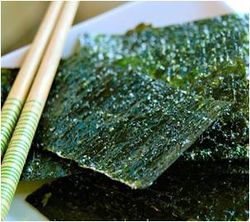

Fig 1,2,3. Left: Agar agar. Middle: thin sheets of Nori. Right: Sushi prepared with Nori.[6][7][8]
Fish feed
Right now the main protein source used as fish feed in fish farming is fish meal. This source however has some disadvantages such as the stability of supply, as fish meal is a fisheries byproduct. Taking into account the decline of the world’s fish stocks together with the rise of fish farming, it is unlikely that the increasing demand for fish meal will be met. Another problem are the excessive levels of phosphorus in fish meal which end up in the water and are likely to cause eutrophication and excess algal growth. Algae would be good candidates to serve as an alternative for fish meal, because ‘plant’-based proteins do not contain such high P levels and they would help taking the pressure off wild fish stocks.[9]
Pharmaceutical and medical applications
Antibiotic, antiviral and antifungal activity
Pharmaceuticals contribute to the fastest growing section of the market. The antibacterial and antifungal activity of various macroalgae have been demonstrated.[10][11] Differences in bioactivity may occur between specimens from different regions, suggesting that the bioactivity of these algae can vary with the geographical sampling zone due to changes in ecological parameters such as irradiance and nutrients.[10]
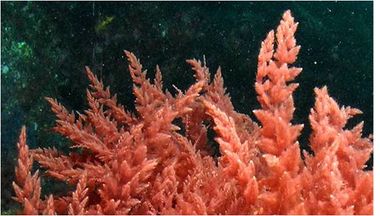
Fig 4. Falkenbergia rufolanosa, a red algae with antibacterial activity.[12]
Viral diseases are still a major cause of human mortality worldwide. Viral therapies mostly fail because of infectious diseases, drug resistance and side effects. Because of this, the development of new kinds of antiviral agents is required urgently and a great deal of interest has been expressed concerning agents derived from marine algae, more precisely from the sulphated polysaccharides.[13]
The contribution of these algae focuses on anti-herpes agents because they are considered novel functional agents.[14]
Anticancer and antileukemic activity
The green algae Bryopsis sp. contains some promising compounds in the field of curing cancer. These Kahalalide F compounds (and its synthetic analogues) are peptides which have shown a potent cytotoxic activity (inhibition of cell growth and multiplication) against human cancer cell lines. Clinical investigation towards the possible treatment of lung, prostate and breast cancer are being performed based on these algal features.[13][15]
Adult T-cell leukemia (ATL) is a deadly malignancy caused by human T-cell leukemia virus type 1 (HTLV-1) infection and remains incurable for now. A research was performed on the activity of fucoxanthin, a xanthophyll found as an accessory pigment in the chloroplasts of brown algae and other heterokonts. The obtained results suggested that both fucoxanthin and its metabolite fucoxanthinol could be potentially useful as therapeutic agents against ATL.[16].[17]
Anti-inflammatory and antioxidant activity
Polysaccharide fractions of the red algae Gracilaria verrucosa were admistered to mice orally and intraperitoneally and showed antioxidant activity as well as anti-inflammatory activity stimulating phagocytosis.[18]
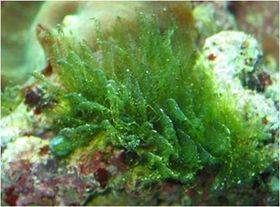
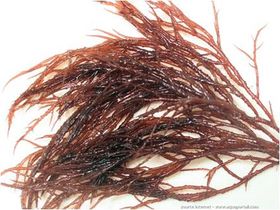
Fig 5, 6. Bryopsis sp., containing promising compounds in the field of curing cancer (left) and Gracilaria verrucosa with Anti-Inflammatory and Antioxidant Activities.[19][20]
Biofuels
Another potentially important product derived from macroalgae are biofuels, driven by the need to find alternative sources to fossil fuels. Macroalgae offer countries provided with a large and suitable coastline a vast renewable energy source. Algal biofuels dispose of quite some benefits compared to fuels of terrestrial origin, such as a higher energy content; a fast growth and the fact that they complement terrestrial biofuels instead of competing with it.[21] Macroalgae are already farmed on a massive scale in Asian countries, to a lesser extent in Europe (particularly in France) and on a research scale in Ireland and Scotland.[22]
Bioremediation
Algae are an increasingly important bioremediation agent used to treat both municipal and industrial wastewater. These algae play a main role in the aerobic treatment of wastewater, they are mostly used for nutrient removal such as nitrogen and phosphorous. Next to this they also have the ability to accumulate and remove toxic compounds such as heavy metals and even pathogens. The algae-based treatment has some advantages over conventional treatments such as a reduction in use of chemicals and lower energy costs. Also, while purifying this waste an algal biomass suitable for biofuels is produced. This biological treatment is thus a very interesting new application, commercial technologies and processes are already available on the market.[23][24]
-Other applications-
Cosmetics
Algae are an excellent choice for the preparation of cosmetic products because of the lipids they contain which can be used to produce oils. Chlorella is the most used genus for the production of cosmetics, other important genera include Scenedesmus, Anabaena, Spirulina et cetera. They are used in several forms such as algal oils, algal powders, algal flour and algal flakes. Products coming from these seaweeds comprise algal soaps, algal clays masks, beauty serums and oils, scrubs, shampoos and so on.[25]
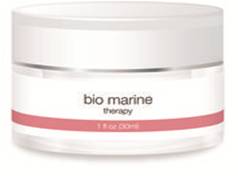
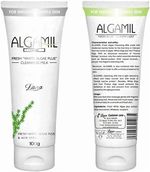
Fig 7. Bio marine therapy and Algamil, two examples of skin care products with algal compounds.[26][27]
Anti-biofilm activity
Salmonella enterica is a leading cause of bacterial food-borne diseases because of its capability to form biofilms on several surfaces in which it is better protected against antimicrobial agents. Brominated furanones extracted from the red algae Delisea pulchra have an interesting application, interfering with this biofilm formation. Long term efficiency however has remained elusive.[28]
Contraceptive activity
Researchers have found that the red algae Gracilaria corticata might be a potential new source for post-coital contraceptive drugs. Extracts from these algae were administered to female rats from day one to seven of their pregnancies. A significant higher post-coital contraceptive activity was obtained in these rats without any marked side effects.[29]
Creation of jobs
The algal industry is able to create a wide variety of jobs ranging from research to engineering, from constructing to farming and from marketing to financial services. Because of its multiple applications, the Algal Biomass Organization predicts the potential for creation of 220,000 jobs in this sector and this by 2020.[2]
References
- ↑ http://www.oilgae.com/ref/report/non-fuel-algae-products.html
- ↑ 2.0 2.1 http://www.ncbi.nlm.nih.gov/pmc/articles/PMC2953405/
- ↑ http://www.ncbi.nlm.nih.gov/pmc/articles/PMC3155369/
- ↑ http://www.carrageenans.com/pl/products
- ↑ http://www.mbari.org/staff/conn/botany/reds/lisa/index.htm
- ↑ http://themoderngelatina.com/gelatin-tips-and-tricks/
- ↑ http://www.aquaportail.com/definition-13080-feuille-de-nori.html
- ↑ ] http://comidanarede.com.br/culinaria-japonesa/aprendendo-sobre-sushi/
- ↑ S. O. Ayoola and A. A. Idowu, Biotechnology and species development in aquaculture (2008), pp. 4722-4725
- ↑ 10.0 10.1 Salvador, N. Antimicrobial activity of Iberian macroalgae (2007), pp. 101-113
- ↑ http://link.springer.com/article/10.1007/s11046-012-9541-z?no-access=true
- ↑ http://naturalhomes.org/naturalliving/red-harpoon.htm
- ↑ 13.0 13.1 http://link.springer.com/article/10.1023/B%3AJAPH.0000047783.36600.ef?no-access=true
- ↑ http://link.springer.com/article/10.1007/s10811-014-0447-7
- ↑ http://diposit.ub.edu/dspace/handle/2445/48635
- ↑ Ishikawa, C. Antiadult T-cell leukemia effects of brown algae fucoxanthin and its deacetylated product, fucoxanthinol (2008) pp. 2702–2712
- ↑ http://www.ncbi.nlm.nih.gov/pubmed/18798263
- ↑ http://www.naturalpharmainternational.com/1/algae_genus_gracilaria_antibacterial_antiviral_antifungal_6992136.html
- ↑ http://www.3reef.com/threads/bryopsis-learn-what-it-is-and-how-to-kill-it.100365/
- ↑ http://www.aquaportail.com/fiche-algue-1483-gracilaria-verrucosa.html
- ↑ http://allaboutalgae.com/benefits/
- ↑ http://www.sams.ac.uk/maeve-kelly/macroalgal-seaweed-culture-for-biofuel-research/
- ↑ http://www.oilgae.com/ref/report/wastewater_treatment/wastewater_treatment.html
- ↑ http://allaboutalgae.com/benefits/
- ↑ http://www.oilgae.com/blog/2012/01/cosmetics-from-algae.html
- ↑ https://www.pinterest.com/cosmeticsol/private-label-products/
- ↑ http://www.alibaba.com/product-detail/ALGAMIL-Fresh-Algae-Cleansing-Milk_10454854.html
- ↑ http://www.ncbi.nlm.nih.gov/pmc/articles/PMC2576703/
- ↑ http://www.ncbi.nlm.nih.gov/pmc/articles/PMC3155369/